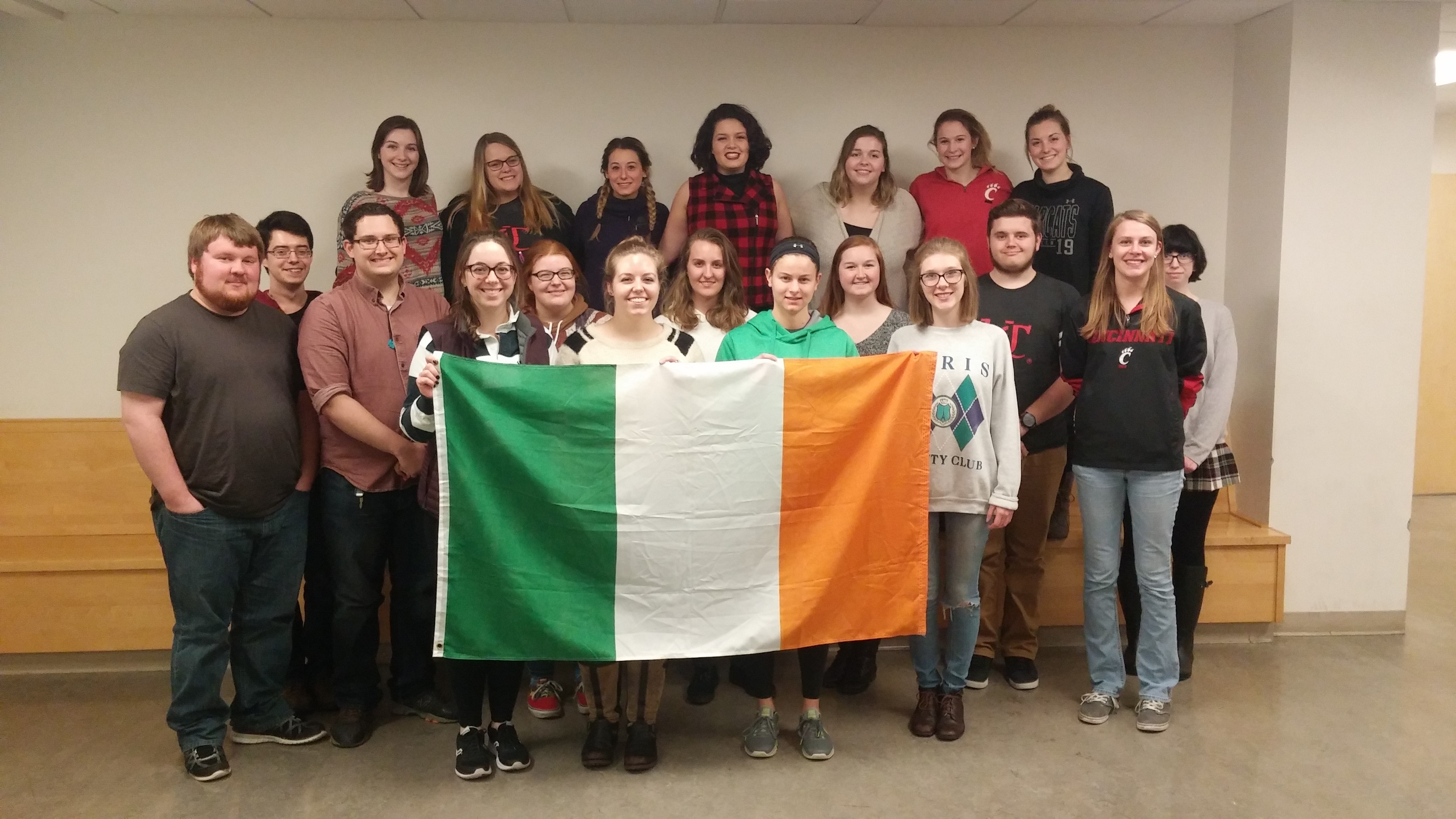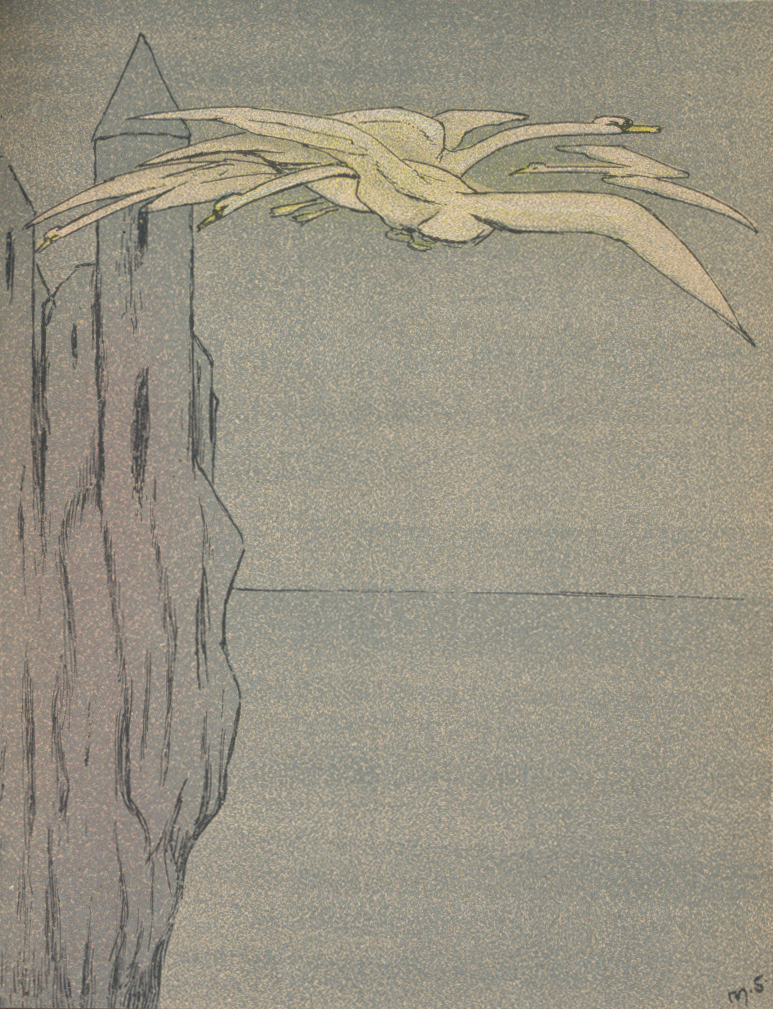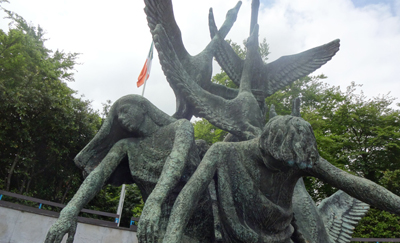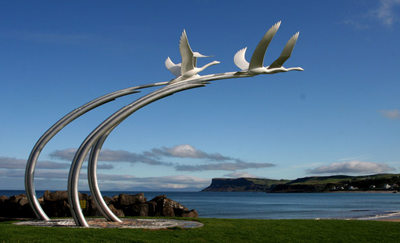By: Sydney Vollmer, ARB Intern
 It’s that time of year again. Winter is *hopefully* leaving and making room for spring. March brings a lot to look forward to, especially for the Irish-American community. Every year since 1991, the president has declared March to be National Irish Heritage Month. But what does Irish heritage mean? One University Honors class is on a mission to find the answer to that question. It turns out that “to be Irish” means a lot more than having red hair, drinking beer, and being one with a short temper. Led by professor Kevin Grace, along with Debbie Brawn of University Honors, 20 students will travel to Ireland over spring break to get an in-depth look at the country from where so many Americans emigrated. The weeks leading up to the study tour were filled with readings of Irish-American literature, such as Angela’s Ashes and Irish America: Coming Into Clover, as well as the viewing of films and many discussions about what Irish heritage means.
It’s that time of year again. Winter is *hopefully* leaving and making room for spring. March brings a lot to look forward to, especially for the Irish-American community. Every year since 1991, the president has declared March to be National Irish Heritage Month. But what does Irish heritage mean? One University Honors class is on a mission to find the answer to that question. It turns out that “to be Irish” means a lot more than having red hair, drinking beer, and being one with a short temper. Led by professor Kevin Grace, along with Debbie Brawn of University Honors, 20 students will travel to Ireland over spring break to get an in-depth look at the country from where so many Americans emigrated. The weeks leading up to the study tour were filled with readings of Irish-American literature, such as Angela’s Ashes and Irish America: Coming Into Clover, as well as the viewing of films and many discussions about what Irish heritage means.
Being a part of the class, I have participated in all these discussions and found a deeper connection to my own Irish heritage. I’ve been very fortunate this semester that I am able to explore the topic in class and at work. At the Archives and Rare Books Library, we have a vast collection of Irish plays, poetry, literature, and folklore. Since I have already been working on highlighting our collections of fairy tales and the like, I decided it would be fun to explore Irish tales this month.
 There are many Irish folktales that, like any other nation’s stories, teach lessons or euphemize history. One popular symbol used in Irish mythology is the swan. The swan often symbolizes light and purity. The people of pre-Christian Ireland also saw swans as creatures that could connect to the Otherworld where the gods and goddesses lived (Kneale). Still today, swans are treated with respect in Ireland. Probably the most famous tale about swans is that of “The Children of Lir” (pronounced LEER). There are many different versions of the tale. The version I’m referencing is from ARB’s collection. The book is Celtic Wonder Tales, retold by Ella Young and illustrated by Maud Gonne. In Young’s retelling of the story, a king named Lir lived in Ireland in a time before the land knew trouble. There, he lived with his four children—Fionnuala, Aodh, Fiacra, and Conn—and their step-mother, Aoifa. Though beloved by their father, Aoifa resented the four children. One day, she took them to the Lake of Darvra in Westmeath. To ensure they would never live under her roof again, she cast a spell on them, causing all four to turn into swans. They were cursed to stay in that lake for three hundred years. At the end of that time, they would migrate to the sea of Moyle for the next three hundred. Afterward, the children-turned-swans were to spend three hundred additional years on the Western Sea. The curse would end only when a king from the North wed a queen from the South, when a druid with a shaven crown came over the seas, and when they heard a prayer bell ringing.
There are many Irish folktales that, like any other nation’s stories, teach lessons or euphemize history. One popular symbol used in Irish mythology is the swan. The swan often symbolizes light and purity. The people of pre-Christian Ireland also saw swans as creatures that could connect to the Otherworld where the gods and goddesses lived (Kneale). Still today, swans are treated with respect in Ireland. Probably the most famous tale about swans is that of “The Children of Lir” (pronounced LEER). There are many different versions of the tale. The version I’m referencing is from ARB’s collection. The book is Celtic Wonder Tales, retold by Ella Young and illustrated by Maud Gonne. In Young’s retelling of the story, a king named Lir lived in Ireland in a time before the land knew trouble. There, he lived with his four children—Fionnuala, Aodh, Fiacra, and Conn—and their step-mother, Aoifa. Though beloved by their father, Aoifa resented the four children. One day, she took them to the Lake of Darvra in Westmeath. To ensure they would never live under her roof again, she cast a spell on them, causing all four to turn into swans. They were cursed to stay in that lake for three hundred years. At the end of that time, they would migrate to the sea of Moyle for the next three hundred. Afterward, the children-turned-swans were to spend three hundred additional years on the Western Sea. The curse would end only when a king from the North wed a queen from the South, when a druid with a shaven crown came over the seas, and when they heard a prayer bell ringing.
Distraught, the children called for wickedness to be thrust onto Aoifa. When Lir found out what happened to his children, wickedness is exactly what Aoifa received—her beauty was driven from her and she was forced to wander desolate forever. When Lir came to see his children, he pleaded with them to return home with him but they could not because of Aoifa’s curse. Still, friends and family came to visit them and they would sing together. When three hundred years passed, they flew to the sea of Moyle where it was cold and stormy. Their years were spent in misery, and Conn almost didn’t survive. After all nine hundred years had passed, they returned to their homeland. However, it was different than when they left. It was no longer the lively place they had known. It was desolate and dreary. Their father’s house was empty, and the swans were filled with sorrow.
 They wanted to be far from the sadness so they flew away. When the swans landed, they met a stranger who asked if they knew how to get to Tir-nan-Oge, which happened to be their homeland. They said there was no use going there, as it was devoid of life. The man, named Aibric, would have none of it. It was his life’s purpose to make it to Tir-nan-Oge and he was determined to get there. Convinced by the man that there was hope in returning home, the swans showed him the way. Once there, Aibric called to the mountain to take pity on them, and the world transformed in response. Everything returned to its former beauty, and a prayer bell was heard in the distance. Aibric took the swans to the church where the bells rang. A queen (from the South) heard about the swans and demanded her husband capture them for her. When the king (from the North) tried to forcibly take the swans, their feathers turned to dust. The children’s souls were released from their swan bodies and joined their parents in the afterlife. Aibric, who had become fond of the swans, lived the rest of his life telling their story to anyone who would listen.
They wanted to be far from the sadness so they flew away. When the swans landed, they met a stranger who asked if they knew how to get to Tir-nan-Oge, which happened to be their homeland. They said there was no use going there, as it was devoid of life. The man, named Aibric, would have none of it. It was his life’s purpose to make it to Tir-nan-Oge and he was determined to get there. Convinced by the man that there was hope in returning home, the swans showed him the way. Once there, Aibric called to the mountain to take pity on them, and the world transformed in response. Everything returned to its former beauty, and a prayer bell was heard in the distance. Aibric took the swans to the church where the bells rang. A queen (from the South) heard about the swans and demanded her husband capture them for her. When the king (from the North) tried to forcibly take the swans, their feathers turned to dust. The children’s souls were released from their swan bodies and joined their parents in the afterlife. Aibric, who had become fond of the swans, lived the rest of his life telling their story to anyone who would listen.
 The Irish still pay homage to this myth. There is a statue of the Children of Lir in Dublin’s Garden of Remembrance and a monument in Ballycastle, County Antrim. Swans that are native to the land are treated with respect because of their ties to mythology and because of their natural grace and beauty.
The Irish still pay homage to this myth. There is a statue of the Children of Lir in Dublin’s Garden of Remembrance and a monument in Ballycastle, County Antrim. Swans that are native to the land are treated with respect because of their ties to mythology and because of their natural grace and beauty.
 Tomorrow, I will be in Ireland and on the lookout for swans. I’ll make sure to take pictures to add to ARB’s Irish Literature site. And when I get back, I’ll post more about Irish folklore. In the meantime, please visit our website at http://libraries.uc.edu/arb.html, follow us on Facebook at https://www.facebook.com/ArchivesRareBooksLibraryUniversityOfCincinnati, and come see us in person. The Archives and Rare Books Library is located on the 8th floor of Blegen Library. Our hours are 8:00 am to 5:00 pm, Monday through Friday. To schedule an appointment, please call us at 513.556.1959 or email us at archives@ucmail.uc.edu. Whether you go far or stay near, have a great spring break!
Tomorrow, I will be in Ireland and on the lookout for swans. I’ll make sure to take pictures to add to ARB’s Irish Literature site. And when I get back, I’ll post more about Irish folklore. In the meantime, please visit our website at http://libraries.uc.edu/arb.html, follow us on Facebook at https://www.facebook.com/ArchivesRareBooksLibraryUniversityOfCincinnati, and come see us in person. The Archives and Rare Books Library is located on the 8th floor of Blegen Library. Our hours are 8:00 am to 5:00 pm, Monday through Friday. To schedule an appointment, please call us at 513.556.1959 or email us at archives@ucmail.uc.edu. Whether you go far or stay near, have a great spring break!
Sources:
http://irelandofthewelcomes.com/the-children-of-lir/
https://www.celtic-weddingrings.com/celtic-mythology/children-of-lir.aspx
https://aliisaacstoryteller.com/2015/06/15/irish-mythology-the-swan/
